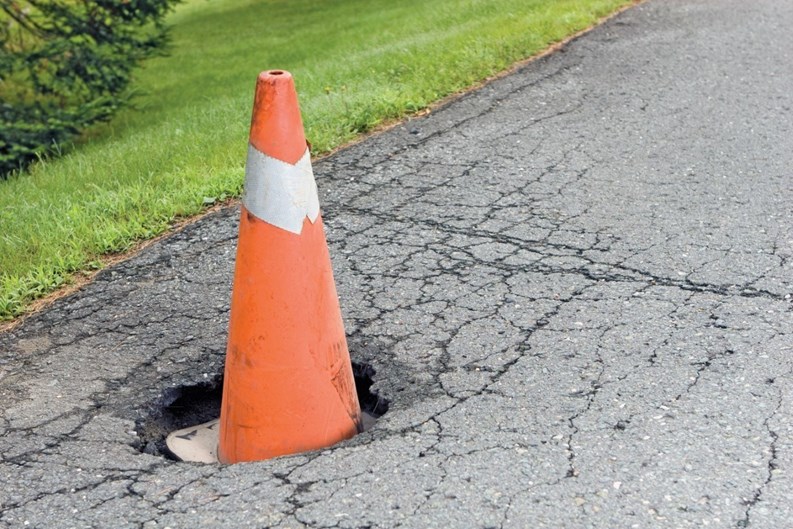Spring beckons, with the promise of all those blossoms bursting with color from early flowering bulbs. If only it were that simple.
Spring beckons, all too often, with fungus on the lawns, desiccated yews, branches dangling from specimen trees and birches bent over from ice and snow load. Then there’s the fencing and rails bashed by snow plows, not tomention cracks and potholes in pavement and clogged drainage systems under the roads.
With such a laundry list of damage at winter’s end, what should the first order of business be for board membersand property managers?
Perhaps the first item to attend to is the condition of roads and paved areas. It’s all about safety, since pavement damage can potentially impede access for residents, and drainage problems can lead to flooding. Engineering standards for storm water management in New England are based on statisticsindicating that intense, prolonged rainfall is an unusual occurrence.
But big storms are no longer rare, notes Ray Bellemore, president of Bellemore Catch Basin Maintenance of Bedford, New Hampshire. “Drainage systems, if they’re not maintained, havebeen failing in the last several years… I’ve seen 80-pound manhole covers get blown out by a huge rain event.”
Clogged Storm Drains
Bellemore’s firm helps property managers grapple with the main source of failure in roadway drainage systems – they get plugged after a winter’s worthof sand and salt application. His crew uses methods that are a far cry from backhoes and shovels. He states, “We maintain storm drainage systems using hydro-excavation,” a method that clears the lines with high-power water jets and collects the water and debris with a vacuum.
Hydro-excavation is actually mandated in several states, as it’s so much safer and cleaner than older methods. Bellemore cites an example: “We recently did a hydro excavation job at an over-55 townhouse association. The water valve failed at the residential tie-in. We actually removed the turf and piled it next to the hole so it could be set back in place. This valve was below the frost line. We used a trench box and excavated to it to allow a serviceman to replace it. The sidewalk, asphalt, and landscape were not impacted and when we put the turf back, it was like we were never there. This job took six hours to complete. It could never have been done by standard digging equipment, as the hole would have been much larger and the cost to repair landscape much greater.”
As mandated by state and federal laws, drainage systems are designed to capture silt or erosion before it can go downstream and into the environment. Bellemore explains how this starts at the catch basins: “A typical [catch basin] design has a surface grate… and down inside, an outlet line positioned above a sump.” This sump is like a sink-hole or depression at the base, where silt or debris is intended to settle and collect, he explains, “and not continue downstream.” Even when repairing clogged lines, the water [that is retrieved] has to be treated before it’s released into the environment, he adds.
“Unfortunately, if you wait until the sumps are totally full, the lines clog and flooding can result,” he notes, adding that the cost of regular maintenance – cleaning just the sumps once or twice a year –is still cheaper than cleaning out the whole system after years of neglect.
One residential community that called in Bellemore’s firm had gone 11 years without cleaning out the sumps –in 30 catch basins on the property. “They had some flooding,” says Bellemore, “at the bottom of the hill, where the drains were no longer taking water. To make matters worse… the problem [and cost] was compounded while jetting out the lines, since there were no hydrants on site and we had to truck in water for the jets. Then, the runoff had to go into water quality units” before being expelled into an adjoining wetland. “The job took over two weeks and cost the manager $12,000,” he adds.
Even though hydro-excavation is the preferred method, and is gaining in popularity, “You’ll still see the claw-truck with a clamshell [that dips into holes] cleaning curb inlets,” observes Bellemore, “especially in Massachusetts [where the hydro method is not mandated]… but the clamshell can beat upstorm drain equipment and the pipes inside the drain. It is still used for beaver dam clean-out, and it’s cheap, but it’s crude and not that efficient.”
Potholes Proliferate
While most managers are aware that catch basin sumps require regular maintenance, the catch basins themselves may also need attention. Modernbasins are pre-cast, but if they are older and constructed from brick or concrete block, they can deteriorate from many winters of road salt.
Richard Goldman, owner of paving company R.L. Goldman Co., Inc., of Westborough, Massachusetts, advises inspections of the structures each spring. “Catch basins have been knownto collapse after salt destroyed the brick or block linings. Even pre-cast basins may have rows of brick around the top, supporting the frame and cover or grate.”
His company does asphalt repair and concrete work for many associations, and he warns that “all cracks in roads and parking areas should be sealed … crack seal [usually a heated, liquid, rubberized asphalt] will work if done before the winter, otherwise it will get worse with the freeze and thaw cycles… You don’t want to disturb the sub-grade[with] water getting under the pavement. When that happens, the best solution is a full-depth patch, completely cutting out the [disturbed] section, adding gravel as needed, then paving with three inches of asphalt.”
He adds that a cheaper solution is “cold patch… where you just fill in the disturbed area and tamp it down,” but this is a temporary fix. “We have a hot mix [that we use] all winter” for emergency patching, he says.
For larger stretches of road repair or replacement, he recommends full-depth reclamation, using special equipment that penetrates the entire top pavement section along with a specific depth of the gravel or base material. These layers are pulverized and blended together, resulting in a homogenous and fully recycled base course. “Other alternatives[for reclamation] include a milling machine… but that only takes off the top two inches—pre-existing cracks may remain below,” says Goldman.
The need for expensive repaving jobsshould not occur in the first place, he adds, “People don’t understand how important the crack sealing procedure is to save the pavement.”
Plants Face Multiple Challenges
In addition to roadway infrastructure, landscape features and plantings represent major investments for many associations, and must be able to withstand a long winter. “Every so often spring arrives with unwanted consequences,” states Daniel C. Bell, MCA, president of Bell Horticulture in Smithfield, Rhode Island. “From trees to shrubs to lawns, nothing seemsto look the way we envisioned spring to look like. What happened? With evergreens, leaf desiccation is often the culprit. Since evergreens keep their leaves and needles year round they continuously transpire and lose water – even in cold weather. Windy weather results in more transpiration which aggravates this problem. Deciduous plants such as hardwood trees and shrubs that lose their leaves each fall do not lose as much water in the dormant season,” he notes.
“Some winters have little snow and very cold temperatures, which results in a rapid freezing of the ground, a deeper permafrost and ultimately, damage to the fine root hairs a plant depends on for water uptake,” he adds. “Both cold wind (desiccation) and frozen soil can cause similar symptoms on the plant such as brown or wilted foliage. Extreme cases can also affect deciduous plants causing the last year’s annual growth and new buds to appear stunted or shriveled. Another cause of winter damage is more obvious. Heavysnow and ice load on trees and shrubs (both evergreens and deciduous) can cause limbs to crack, split or break off entirely. In more severe conditions, the entire plant can be destroyed.”
The effects of winter damage can be lessened by mulching around the base of smaller plants –especially evergreens and, if the location is susceptible to strong winter winds, a protective barrier can be installed around the plant. “Physical damage due to ice and snow can be reduced by proper pruning and the installation of support cables between limbs that may be prone to breaking under snow and ice,” Bell says.
“Employing a certified or licensed arborist is essential,” recommends Bell. “Check with your state’s arborist association for a list of qualified arborists and whether a license is required. You should also request a certificate of insurance from the tree care company before any work is authorized.
“Winter damage to turf is also a common occurrence,” he continues. “Snow molds are one of the most widespread diseases and are caused by long periods of cold and ice covering the grass. As with any landscape plant, soil conditions such as proper Ph and the availability of essential nutrients canhelp reduce the damage and facilitate rejuvenation during the spring. Employing a qualified lawn care specialist will help with diagnosing and eliminating problems associated with winter damage.”
Plant-Hardiness Zones
David Hawkins, an arborist for Urban Forestry Solutions, Inc. of Pelham, Massachusetts, suggests “paying attention to your plant-hardiness zone,” when choosing landscape plantings, and more importantly, “determine the actual areas where micro-climates exist” on the property. These may be corners or areas shielded by buildings or fencing that reduce effects from wind, precipitation or sun, and may alter the ambient temperature. Aside from the shielding caused by man-made features, intensity of sunlight can vary according to any hills, outcrops or depressions in the terrain. All these surface variations may also channel groundwater, creating wet spots and yet another micro-climate.
To find trees and shrubs that are “at home” in the local climate, it seems sensible to stick to native species. That may be tricky, Hawkins points out, since New England’s landscape before Europeans arrived was “mostly mature forests filled with white pine, oak, chestnut and a few maple varieties.” The original forests almost totally became farmlands, and only during the20th Century did a forest re-growth occur. “The resulting, successional forests we see today,” he continues, “are naturalized species, with trees and understory plants” that migrated here or were brought in as crops or decorative specimens.
The spectrum of plant choices for any particular hardiness zone may therefore be quite wide. It’s just a matter of narrowing all the choices down to the best varieties for a particular community’s topography, soils and micro-climates.
The big investment that associations make in landscapes and infrastructuresis challenged each winter and as the experts stress, preparing in the fall is much more effective than repairing in the spring.
Marie N. Auger is a freelance writer and a frequent contributor to New England Condominium magazine.







Leave a Comment